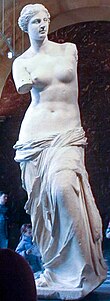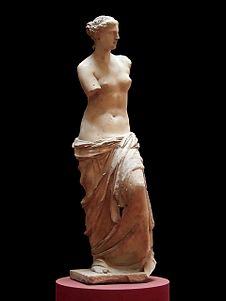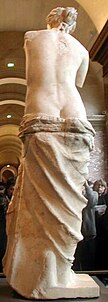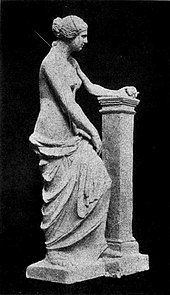Statues Throughout History Venus De Milo Statue Art Tyoe
| Venus de Milo | |
|---|---|
| Greek: Αφροδίτη της Μήλου | |
 | |
| Creative person | Alexandros of Antioch |
| Twelvemonth | Betwixt 150 and 125 BC |
| Medium | Parian marble |
| Subject | Venus |
| Dimensions | 204 cm (6 ft viii in) |
| Status | Arms broken off; otherwise intact |
| Location | Louvre, Paris |
The Venus de Milo (; Greek: Αφροδίτη της Μήλου, romanized: Afrodíti tis Mílou ) is an ancient Greek sculpture that was created during the Hellenistic catamenia, sometime between 150 and 125 BC.[ane] It is 1 of the most famous works of ancient Greek sculpture, having been prominently displayed at the Louvre Museum since presently subsequently the statue was rediscovered on the island of Milos, Hellenic republic, in 1820.
The Venus de Milo is believed to depict Venus, the Roman counterpart of Aphrodite. Some scholars theorize that the statue actually represents the sea-goddess Amphitrite, who was venerated on the island in which the statue was found.[two] The work was originally attributed to the 4th century Athenian sculptor Praxiteles, but, based upon an inscription on its plinth, it is at present widely agreed that the statue was created before, and instead is the work of Alexandros of Antioch.[3]
Fabricated of Parian marble, the statue is slightly larger than life size, standing 204 cm (6 ft 8 in) high.[4] The statue is missing both artillery, with part of one arm, as well as the original plinth, existence lost afterwards the statue's rediscovery.
The sculpture is sometimes called the Aphrodite de Milos , due to the imprecision of naming the Greek sculpture after the Roman deity Venus.[5]
Description [edit]
The Venus de Milo is a 204 cm (6.69 ft) alpine Parian marble statue of a Greek goddess, nearly likely Aphrodite, depicted half-clothed with a bare torso. The statue originally would have had two arms, two feet, both earlobes intact and a plinth; early sketches post-obit the statue'southward rediscovery show part of the left arm and the plinth, though not the missing left human foot, intact, but these were afterward lost later the statue'south rediscovery.
Though further damaged following rediscovery, the reason backside the Venus de Milo's arms being missing in the first place is unknown.[six] [ page needed ] In that location is a filled hole beneath her right chest that originally contained a metallic tenon that would take supported the separately carved right arm. Without arms, information technology is unclear what the statue originally looked similar, but fabric archeologist Elizabeth Wayland Barber notes that the posture of Venus de Milo suggests that she may accept been paw spinning.[seven] [viii]
Discovery and History [edit]
Discovery [edit]

Site of the discovery of the Venus de Milo
Information technology is generally asserted that the Venus de Milo was discovered on 8 April 1820 past a peasant named Yorgos Kentrotas, inside a buried niche within the ancient city ruins of Milos. Milos is the current village of Trypiti, on the island of Milos (besides called Melos, or Milo) in the Aegean, which was and so a part of the Ottoman Empire.[nine]
Elsewhere, the discoverers are identified as Yorgos Bottonis and his son Antonio. Paul Carus gave the site of discovery as "the ruins of an ancient theater in the vicinity of Castro, the capital of the island", adding that Bottonis and his son "came accidentally across a pocket-sized cave, advisedly covered with a heavy slab and curtained, which contained a fine marble statue in 2 pieces, together with several other marble fragments. This happened in February, 1820". He plainly based these assertions on an commodity he had read in the Century Magazine.[10]
The Australian historian Edward Duyker, citing a alphabetic character written past Louis Brest who was the French delegate in Milos in 1820, asserts the discoverer of the statue was Theodoros Kendrotas and that he has been confused with his younger son Georgios (known phonetically as Yorgos) who subsequently claimed credit for the discover. Duyker asserts that Kendrotas was taking stone from a ruined chapel on the edge of his property – terraced country that had once formed office of a Roman gymnasium – and that he discovered an oblong cavity some 1.2 yard × ane.5 one thousand (3 ft xi in × 4 ft 11 in) deep in the volcanic tuff. It was in this crenel, which had three wings, that Kendrotas first noticed the upper part of the statue.[11]
The consensus is that the statue was found in two big pieces (the upper torso and the lower draped legs) forth with several herms (pillars topped with heads), fragments of the upper left arm and left paw holding an apple, and an inscribed plinth.

Front view

Three-quarter view

Back view
Fame [edit]

Upon its discovery in 1820, the Venus de Milo was considered to be a significant artistic finding, but did not gain its status as an icon until later on. The verbal circumstances in which she was discovered, however, are uncertain. The Louvre and in plow, French art every bit a whole, had suffered bang-up losses when Napoleon's looted fine art collection was returned to their countries of origin. The museum lost some of its virtually iconic pieces, like Rome's Laocoon and His Sons and Italia's Venus de Medici. The hole that this left in French culture allowed the perfect path for the Venus de Milo to become an international icon. Based on early drawings, the plinth that had been discrete from the statue was known to take dates on it, which revealed that it was created later on the Classical period, which was the nigh desirable artistic menstruation. This acquired the French to hide the plinth, in an endeavour to conceal this fact before the statue's introduction to the Louvre in 1821. The Venus de Milo held a prime spot in the gallery, and became iconic, mostly due to the Louvre'due south branding campaign and accent on the statue's importance in lodge to regain national pride.
The groovy fame of the Venus de Milo during the 19th century owed much to a major propaganda effort by the French authorities. In 1815, France had returned the Venus de' Medici (also known as the Medici Venus) to the Italians, later on information technology had been looted by Napoleon Bonaparte. The Medici Venus, regarded equally one of the finest classical sculptures in existence, caused the French to promote the Venus de Milo as a greater treasure than that which they recently had lost. The statue was praised dutifully by many artists and critics as the epitome of graceful female beauty. Withal, Pierre-Auguste Renoir was among its detractors, labelling it a "large gendarme".[12] [ folio needed ]
Evacuation from the Louvre museum during World War Two [edit]
During the start of the German invasions during World War II, Jacques Jaujard, the director of the French Musées Nationaux, anticipating the fall of France, decided to organize the evacuation of the Louvre art collection to the provinces.[13] Venus de Milo along-with The Winged Victory of Samothrace were kept at Château de Valençay, which was spared the German occupation on a technicality.
Modern use [edit]

A restoration proposal by archaeologist and art historian Adolf Furtwängler in 1916 showing how the statue may take originally looked
The statue has greatly influenced masters of mod art; ii prime examples are Salvador Dalí's 1936 painting Venus de Milo with Drawers [14] and his The Hallucinogenic Toreador (1969–70) and its repeated images of the statue.
The statue was formerly office of the seal of the American Order of Plastic Surgeons (ASPS), one of the oldest associations of plastic surgeons in the world.[15]
In February 2010, the German mag Focus featured a doctored image of this Venus giving Europe the middle finger, which resulted in a defamation lawsuit against the journalists and the publication.[sixteen] They were institute non guilty by the Greek court.[17]
Inspired works [edit]
Many modernistic artists have been inspired by the statue piece since it commencement arrived at the Louvre. I of the more than notable pieces was created by French Post-Impressionist painter Paul Cézanne who drew a pencil study in 1881. Another inspired piece of work was by René Magritte, who painted a reduced-calibration version of plaster, with bright pinkish and night blue, entitled Les Menottes de Cuivre or The Copper Handcuffs in 1931. Fifty-fifty more than recently are the works of Neo-Dada Popular artist Jim Dine, who has frequently utilized the Venus de Milo in his sculptures and paintings since the 1970s. Perhaps the virtually widely-known adaptation is that of Salvador Dalí, with his 1936 cosmos Venus de Milo aux tiroirs (Venus of Milos with Drawers). The Spanish Surrealist created a half-size plaster cast, painted it, and covered the slightly open up drawers with metallic knobs and fur pom-poms. This inspired recreation of the famous sculpture was meant to display the "goddess of love as a fetishistic anthropomorphic cabinet with secret drawers filled with a maelstrom of mysteries of sexual desires that just a mod psychoanalyst tin interpret" (Oppen & Meijer, 2019).
The image of the Venus de Milo is seen constantly in modernistic culture, whether information technology be in magazines, advertisements, or home decor.
Cultural references [edit]
The Venus de Milo, equally one of the world's almost recognized artworks, has been referenced countless times in pop civilization.
A common comedic gag is depicting how the statue allegedly lost its arms. In 1960, Charlie Drake performed a one-act sketch which showed museum employees accidentally breaking off the arms while packing it.[18] The 1964 film Deport On Cleo similarly featured a skit which purported to show how the statue lost its arms. In the 1997 Disney picture show Hercules, the championship grapheme skips a stone and inadvertently breaks both arms off the statue.
A plot to steal the statue is at the eye of the 1966 spoof spy film The Last of the Secret Agents?, starring Marty Allen and Steve Rossi.
The Venus de Milo is often featured and parodied in television shows, such as The Tick episode "Armless merely Not Harmless", in which villains "Venus and Milo" rob an art museum, and the BBC sitcom Only Fools and Horses, where Del Boy shows Rodney a model of the statue challenge there are sick-minded people in the world who would make such a statue of a disabled person.
Music [edit]
The statue is also ofttimes referenced in music. Notable examples include:
- The 1934 song "Honey Is Just Around the Corner" by Lewis E. Gensler and Leo Robin, which contains the lyrics, "Venus de Milo was noted for her charms, simply strictly between us, you're cuter than Venus, and what's more than you've got arms."
- The 1941 song "Chocolate Milk shake", by Duke Ellington, which contains the lyrics, "Venus de Milo had charms; she gave the Greeks quite a intermission. Now that poor gal is minus her arms, from doin' the Chocolate Milk shake."
- The 1956 song "Dark-brown Eyed Handsome Man", written by Chuck Berry and covered by Buddy Holly, contains the lyrics: "The Venus de Milo was a beautiful lass. She held the earth in the palm of her mitt. She lost both her arms in a wrestling lucifer to win a brown-eyed handsome man." In afterward covers such every bit Waylon Jennings version off of his 1970 anthology Waylon he changes it to but "Milo Venus" and other lyrics too.
- "Venus de Milo" is a track on Miles Davis' 1957 album Birth of the Absurd.
- "Venus de Milo" is a instrumental runway on Prince and the Revolution' 1986 album Parade.
- "Venus", the second vocal on Television's 1977 debut anthology Marquee Moon, depicts the vocalist falling into "the arms of Venus de Milo."
- "Touch Too Much" by AC/DC (lyrics past Bon Scott) describe a woman using a reference to the work: "She had the face of an angel, smiling with sin. A body of Venus with arms."
- Multiple songs by Ricardo Arjona reference the Venus de Milo, including "No te cambio por nada" , which features the lyric (translated to English): "No, no, no, I will not trade you lot for anything, not even for a trip to Fiji with the Venus de Milo..."
- The song "Please Don't Coffin Me" past John Prine contains the lyrics "Venus DeMilo can have my artillery..."
- The 1997 song "Jupiter" by Gem opens with the lyrics: "Venus De Milo in her half-baked shell understood the nature of honey very well..."
Encounter also [edit]
- Aphrodite of Knidos
References [edit]
- ^ Kousser, Rachel (2005). "Creating the Past: The Vénus de Milo and the Hellenistic Reception of Classical Greece". American Periodical of Archeology. 109 (ii): 227–250. doi:10.3764/aja.109.2.227. ISSN 0002-9114. JSTOR 40024510.
- ^ "Aphrodite Known Venus de Milo". Louvre.fr. French republic.
- ^ "Base Charade". Smithsonian . Retrieved 28 August 2019.
- ^ "statue; Vénus de Milo". Musée du Louvre . Retrieved 27 Apr 2021.
- ^ "Aphrodite | Mythology, Worship, & Art". Encyclopedia Britannica . Retrieved 9 April 2021.
- ^ Curtis 2003.
- ^ Postrel, Virginia (1 May 2015). "What Was the Venus de Milo Doing With Her Arms?". Slate. ISSN 1091-2339.
- ^ Fessenden, Marissa (vi May 2015). "The Mystery of What Venus de Milo Was Once Belongings". Smithsonian Magazine . Retrieved 4 January 2021.
- ^ Venus de Milo at the Encyclopædia Britannica
- ^ Carus, Paul (1916). The Venus of Milo: An Archeological Study of the Goddess of Womanhood. Open up Court Publishing Company. p. two. Retrieved 6 April 2018.
- ^ Duyker 2014, pp. 61–62.
- ^ Bonazzoli, Francesca; Robecchi, Michele (2014). Mona Lisa to Marge: How the World's Greatest Artworks Entered Pop Civilization. New York: Prestel. ISBN9783791348773.
- ^ "Saviour of France'southward art: how the Mona Lisa was spirited away from the Nazis". The Guardian. 22 November 2014. Retrieved 13 January 2018.
On 25 August 1939, Jaujard closed the Louvre for three days, officially for repair work. For three days and nights, hundreds of staff, art students and employees of the Grands Magasins du Louvre department store carefully placed treasures in white wooden cases.
- ^ "Venus de Milo with Drawers (and PomPoms)". archive.thedali.org . Retrieved 21 August 2019.
- ^ Brent, Burt (2008). "The Reconstruction of Venus: Following Our Legacy". Plastic and Reconstructive Surgery. 121 (half-dozen): 2170–2171. doi:10.1097/PRS.0b013e318170a7b6.
- ^ Diehn, Sonya Angelica (1 Dec 2011). "Greece Pursues Venus Defamation Case". Courthouse News Service. Archived from the original on 7 December 2011. Retrieved 7 December 2011.
- ^ "Griechisches Gericht spricht FOCUS-Journalisten frei" [Greek Court acquits Focus journalists]. Burda Newsroom (in German language). 3 April 2012. Archived from the original on 15 July 2012.
- ^ "Charlie Drake'south Christmas Show". 26 December 1960. p. 25 – via BBC Genome.
Sources [edit]
- Curtis, Gregory (2003). Disarmed: The Story of the Venus de Milo. New York: Alfred A. Knopf. ISBN978-0375415234. OCLC 51937203.
- Duyker, Edward (2014). Dumont d'Urville: Explorer and Polymath. Dunedin, New Zealand: Otago University Printing. ISBN978-1877578700.
- Nicholas, Lynn H. (May 1995) [1994]. The Rape of Europa: The Fate of Europe's Treasures in the Third Reich and the Second Globe War. New York Urban center: Vintage Books. ISBN978-0-679-40069-ane. OCLC 32531154.
- Venus de Milo: The Oxford Lexicon of Art
- James Grout, Venus de Milo, role of the Encyclopædia Romana
External links [edit]
- Musée du Louvre – Louvre Museum: Venus de Milo
- 3D model of Venus de Milo via photogrammetric survey of an 1850 Louvre atelier plaster cast at Skulpturhalle Basel museum
- A Voice documentary discussing the modern history of the Venus
hannafordtiolsell.blogspot.com
Source: https://en.wikipedia.org/wiki/Venus_de_Milo
0 Response to "Statues Throughout History Venus De Milo Statue Art Tyoe"
Post a Comment